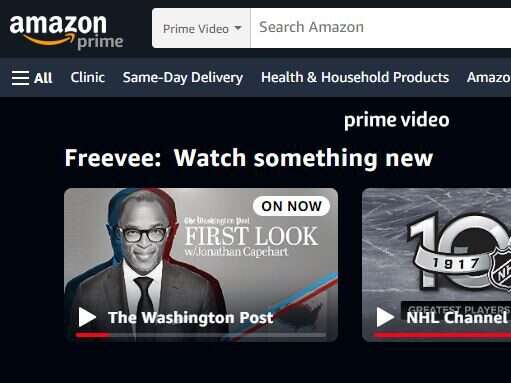
On Tuesday The Washington Post began broadcasting on a new medium: a FAST channel, hosted on Amazon Freevee.
Is this something other news publishers should be doing too? What is a FAST channel? What’s an Amazon Freevee? Did I miss slow channels?
Press Gazette digests the development below.
What is a FAST channel?
FAST stands for free ad-supported streaming television. Free is the key word, differentiating FAST video from services like Netflix that require subscriptions.
Free streaming services can be either on-demand or linear. Examples of the on-demand sort might include the free versions of Channel 4’s on-demand streaming service or ITVX. These services let viewers choose from a catalogue of programmes to watch at a time of their choosing, and are also referred to as AVOD (advertising-based video on demand).
The Washington Post’s new offering, though, is one of a growing number of linear free streaming channels, often referred to as FAST.
Unlike an on-demand offering, FAST channels are scheduled services that run continuously and do not give viewers any choice beyond switching between different channels. The experience of using a FAST channel is more similar to traditional TV than a modern streamer.
Most FAST channels are accessed via a streaming platform or device, for example an Apple TV, Amazon Fire Stick, Roku, Viki or Tubi.
Why are we hearing about them now?
FAST channels are becoming more popular. Amazon said at trade show Newfronts this week that monthly viewing figures for FAST programming via its Fire devices had grown 300% in the prior six months, prompting it to launch a new hub for those services.
Meanwhile in April in the US Google launched Google TV, featuring more than 800 free live TV channels organised within a Live tab. It claimed its service offered the most free TV channels in one go compared to any other smart TV platform.
The Verge hailed FAST and AVOD last week as “the future of TV”, citing a global slowdown in subscriber streaming service sign-ups. The theory is that, as consumers are squeezed and look to cut spending, they’ll use free television services to get their media. Broadcasters can then place advertisements against the content they stream.
Which news publishers run a FAST channel already?
Many broadcasters already have FAST channels: for example, Press Gazette’s March watchathon of GB News was in part carried out using the GB News app on an Amazon Fire Stick. More established broadcast news outlets like Sky News, Al Jazeera, NBC News and Bloomberg also have FAST channels.
Besides The Washington Post, the only other text-first news outlet Press Gazette has found to have launched a FAST channel is The Guardian, which established its service on Rakuten TV in March 2022 and continues to broadcast. Press Gazette has written previously about The Guardian’s efforts in video, which in 2021 yielded it an Oscar.
[Read more: Youtube for publishers – Sun and Guardian explain how to succeed on video platform]
What’s The Washington Post doing?
The Washington Post launched “Washington Post Television” on Tuesday, promising it would be “a premium free streaming service… available 24 hours, seven days a week”.
The channel is available on Amazon’s FAST platform, Freevee, with streaming technology service Amagi providing technical and monetisation support. The Post is owned by Jeff Bezos, who also founded and runs Amazon.
On Saturday Washington Post Television will carry live coverage of the coronation of King Charles, featuring an anchor and reporter broadcasting from London, although it appears the channel is not available in the UK.
The Post says the channel will carry “discussions with the world’s top business leaders, entertainment personalities and authors as part of Washington Post Live, the newsroom’s live journalism platform”.
This is not the Post’s first foray into video. The paper has more than two million subscribers on Youtube, and was an early Tiktok news success.
[Read more: A guide to TikTok for publishers, featuring ‘Washington Post TikTok guy’]
Email pged@pressgazette.co.uk to point out mistakes, provide story tips or send in a letter for publication on our "Letters Page" blog
